 W
WAgathidinae is a subfamily of braconid parasitoid wasps. Some species have been used in biological control programs.
 W
WAgathis is a genus of braconid parasitoid wasps. This genus was established by Latreille in 1804, and the type species is Agathis malvacearum Latreille, 1805. There are at least forty six species of Agathis in the western palearctic region.
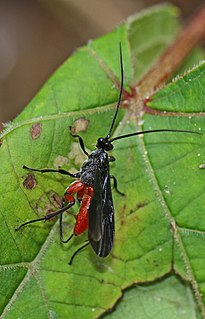 W
WAlabagrus is a genus of braconid wasps in the family Braconidae. There are at least 100 described species in Alabagrus.
 W
WAlabagrus texanus is a species of braconid wasp in the family Braconidae.
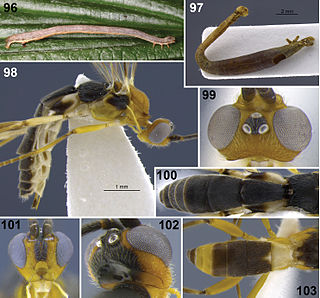 W
WAleiodes is a genus of the family Braconidae of parasitoid wasps described by Constantin Wesmael in 1838. They are also known as mummy-wasps. The female attacks caterpillars of various species, including many pests such as Gypsy moths and tent caterpillars, and then deposits eggs in the caterpillars. The eggs hatch and the wasp larva feeds on the caterpillar, leaving a hardened caterpillar skin, or mummy. The wasp pupates within the mummy and eventually the adult breaks out, leaving a small hole in the husk of the caterpillar.
 W
WThe Alysiinae are a subfamily of braconid parasitoid wasps with over 1000 described species. Several species have been used in biocontrol programs. They are closely related to the Opiinae.
 W
WApanteles is a very large genus of braconid wasps, containing more than 600 described species found worldwide. There are no native species in New Zealand, and none have been recorded in the high arctic.
 W
WAsobara is a genus of parasitoid wasps in the family Braconidae. The genus is best known for the Drosophila parasitoid Asobara tabida, which is notable as both a model for parasitoid wasp infection in insects, and also as a representative of the hologenome theory of evolution. Asobara tabida is commensally infected with Wolbachia, and cannot reproduce in the absence of Wolbachia infection. As such, the genome of Asobara is directly tied to the genome of its commensal Wolbachia symbiont, and the two are considered to have a hologenome.
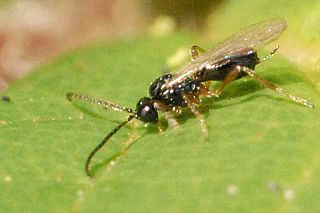 W
WBlacini is a tribe of braconid Parasitoid wasps. Formerly the subfamily Blacinae, this group was demoted to a tribe and placed within the Brachistinae based on molecular evidence in 2011.
 W
WBrachistinae is a subfamily of braconid wasps in the family Braconidae.
 W
WThe Braconinae are a large subfamily of braconid parasitoid wasps with more than 2,000 described species. Many species, including Bracon brevicornis, have been used in biocontrol programs.
 W
WBraconini is a tribe of wasps in the subfamily Braconinae.
 W
WCallibracon is a genus of wasps in the family Braconidae.
 W
WCenocoelius is a genus of hymenopteran insects belonging to the family Braconidae. Those species whose life history has been studied are all koinobiont parasitoids on wood-boring beetle larvae.
 W
WThe Cheloninae are a cosmopolitan subfamily of braconid parasitoid wasps.
 W
WChorebus is a genus of parasitoid wasps in the family Braconidae.
 W
WChorebus lateralis is a species of parasitoid wasp.
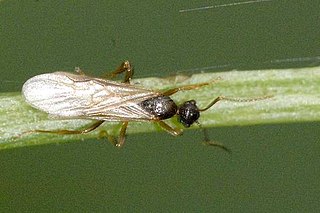 W
WCoelinidea elegans is a wasp species in the genus Coelinidea and the family Braconidae. It is found in Europe.
 W
WColastes is a genus of braconid wasps in the family Braconidae. There are at least 80 described species in Colastes.
 W
WCotesia is a genus of braconid wasps first described by Peter Cameron in 1891. Some species parasitize caterpillars of species considered pests, and are used as biocontrol agents. Cotesia congregata parasitizes the tomato and the tobacco hornworms. C. glomerata and C. rubecula feed on the cabbage white and other white butterfly caterpillars. C. gonopterygis and C. risilis are host-specific and parasitize the common brimstone.
 W
WCotesia glomerata, the white butterfly parasite, is a small parasitic wasp species belonging to family Braconidae. It was first described by Carl Linnaeus in his 1758 publication 10th edition of Systema Naturae.
 W
WDiaeretiella rapae is a species of cosmopolitan parasitoid wasp. It parasitizes many species of aphids, but especially the cabbage aphid, Brevicoryne brassicae. It is the only species in the genus Diaeretiella.
 W
WDiolcogaster is a genus of parasitoid wasps within the subfamily Microgastrinae of the family Braconidae. The genus is poorly studied, likely with multiple undescribed species. The type species is Diolcogaster melligaster (Provancher, 1886), formerly Microgaster melligaster. Species in this genus parasitize lepidopterans and are geographically widespread. There are more than 140 described species in Diolcogaster found throughout the world.
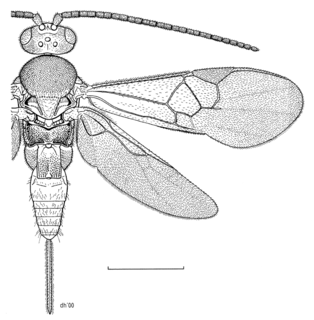 W
WDolichogenidea is a genus of parasitoid wasps in the family Braconidae. There are more than 360 described species in Dolichogenidea, found throughout the world.
 W
WEubazus is a genus of braconid wasps in the family Braconidae. There are at least 140 described species in Eubazus.
 W
WThe Euphorinae are a large subfamily of Braconidae parasitoid wasps. Some species have been used for biological pest control. They are sister group to the Meteorinae.
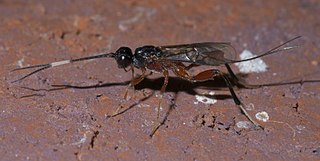 W
WHelconinae is a subfamily of braconid wasps in the family Braconidae. This is a large subfamily with many changes to classification and included groups over the years. There are about 40 genera world wide in this subfamily.
 W
WHeterospilus is a genus of braconid wasps in the family Braconidae. There are at least 130 described species in Heterospilus.
 W
WHygroplitis is a genus of braconid wasps in the family Braconidae. There are about nine described species in Hygroplitis, found in the Holarctic.
 W
WHypomicrogaster is a genus of braconid wasps in the family Braconidae. There are more than 40 described species in Hypomicrogaster, found in North, Central, and South America.
 W
WIvondrovia grangeri is a species of parasitoid wasp belonging to the subfamily Doryctinae of the family Braconidae. It is endemic to Kenya.
 W
WIvondrovia seyrigi is a species of parasitoid wasp belonging to the subfamily Doryctinae of the family Braconidae. It is endemic to Madagascar.
 W
WLytopylus is a genus of parasitoid wasps in the family Braconidae. As members of the subfamily Agathidinae, they are koinobiont endoparasitoids of caterpillars. This genus is primarily found in the neotropics, but ranges from the northeastern United States to Argentina. There are 39 species of Lytopylus, and many more undescribed.
 W
WThe Macrocentrinae are a subfamily of braconid parasitic wasps. Several species have been used in biological control programs.
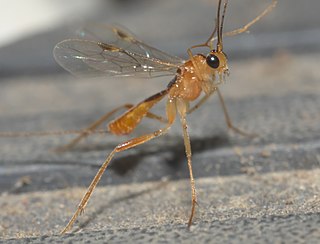 W
WMacrocentrus is a genus of braconid wasps in the family Braconidae. There are at least 180 described species in Macrocentrus.
 W
WMeteorinae is a subfamily of braconid parasitoid wasps. Several species have been used in biological control programs. The name for this group comes from the pupal stage, which, in species attacking Lepidopteran hosts, hangs suspended from a long thread of silk.
 W
WMeteorus is a genus of parasitoid wasps in the family Braconidae. It comprises over 330 species worldwide.
 W
WMeteorus rubens is a species of parasitoid wasp in the family Braconidae which attacks significant crop pests including the black cutworm, Agrotis ipsilon. The wasps have been shown to be easily collected through the use of traps baited with mustard oils. They have been shown to carry Rioviridae RNA viruses, one of only a few parasitoids to carry them.
 W
WMicroplitis is a genus of braconid wasps in the family Braconidae. There are more than 190 described species in Microplitis, found throughout the world.
 W
WMicroplitis mandibularis is a gregarious parasitoid wasp in the family Braconidae (Hymenoptera).
 W
WPeristenus is a genus of parasitoid wasps belonging to the family Braconidae.
 W
WPhanerotoma is a genus of braconid wasps in the family Braconidae. There are at least 190 described species in Phanerotoma.
 W
WPhiloplitis is a genus of braconid wasps in the family Braconidae. There are about nine described species in Philoplitis, found in Africa and Indomalaya.
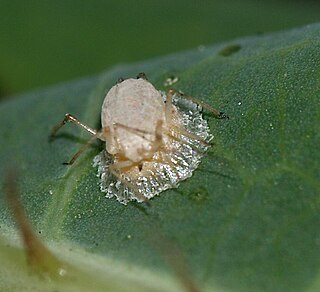 W
WPraon is a genus of braconid wasps in the family Braconidae. There are at least 70 described species in Praon.
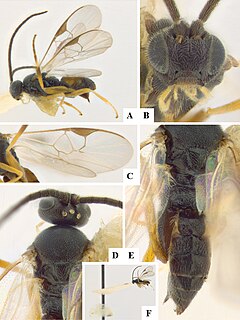 W
WProtapanteles is a genus of braconid wasps in the family Braconidae. There are more than 20 described species in Protapanteles, found mainly in the Holarctic.
 W
WProtomicroplitis is a genus of braconid wasps in the family Braconidae. There are at least three described species in Protomicroplitis, found in the New World.
 W
WPygostolus is a genus of braconid wasps in the family Braconidae. There are about eight described species in Pygostolus.
 W
WRogas is a genus of braconid wasps in the family Braconidae. There are at least 100 described species in Rogas.
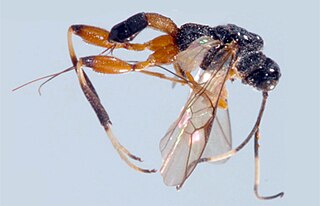 W
WSpasskia brevicarinata is a species of parasitoid wasp native to the Guizhou and Yunnan provinces of China. The female body is 8.2 millimeters long, with 7.3 millimeter forewings. The ovipositor, when fully extended, measures 5.5 millimeters long. General coloration is black, however, the first tergite is yellow. The fore and mid legs are also yellow, while the hind pair are reddish-brown and whitish-yellow. The antennae are dark brown, with a whitish-yellow stripe between the 11th and 15th flagellomeres No males of the species have been observed to date. The species name is derived from Latin brevi, meaning "short" and carinata, the word for "carina". This literally means that the species has a short dorsal carinae as part of the first tergite.
 W
WSpathius is a genus of doryctine wasps. The larvae of this genus of wasps feed on beetle larvae. They act as controllers of the parasitic Hylurgopinus rufipes.
 W
WTrachionus is a genus of braconid wasps in the family Braconidae. There are about 13 described species in Trachionus.
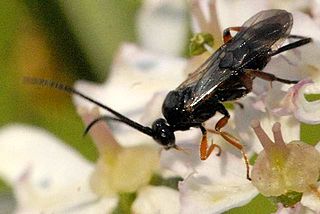 W
WTriaspis is a genus of braconid wasps in the family Braconidae. There are at least 110 described species in Triaspis.
 W
WWroughtonia is a genus of braconid wasps in the family Braconidae. There are at least 30 described species in Wroughtonia.
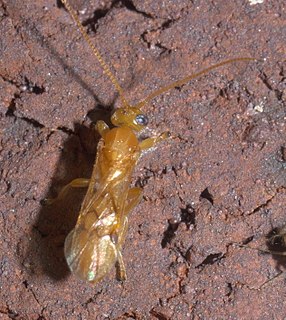 W
WYelicones is a genus of braconid wasps in the family Braconidae. There are at least 120 described species in Yelicones.
 W
WYelicones delicatus is a species of braconid wasp in the family Braconidae.